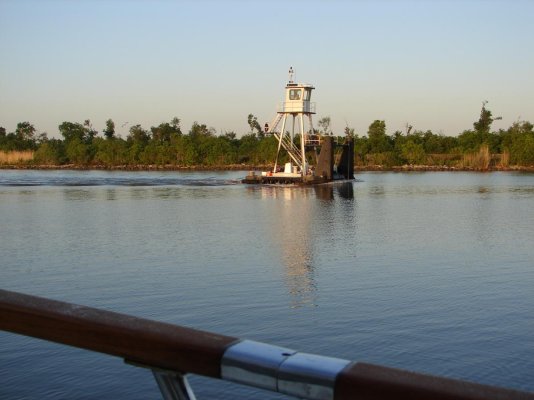ulysses
Guru
One of my pet peeves (I have enough to start a zoo) is the usage of "tug", "barge", "tow" and "towboat/pushboat". I would like to explain the usage of these terms as applied to the Gulf Coast Inland Waterways and Western Rivers.
Tug- a typically model (pointy) bow boat used to assist ships to and from docks. Ocean going tugs are also used in large bodies of water pulling or towing large ocean going barges. Some of these are capable of fitting into a notch at the stern of their barge and pushing for greater control in smaller or restricted bodies of water.
barge - A vessel designed to carry large capacity cargoes (bulk or liquid) and is not normally self propelled. There are some that may be self-propelled but in my book that makes them a boat. River barges are typically 195' x 35' with a potential for 9'-10' draft and are flat bottomed. At 8' draft they usually are carrying in excess of 1400 tons.
Tow - as a NOUN- one or more barges linked together by wire and ratchets. Typically 1-6 barges are linked and pushed on the ICW. Usually 15 on the Upper, Tenn. and Ohio Rivers. Often over 50 on the Lower Miss. Once they are all linked together they are referred to as the "tow" and a "Towboat/Pushboat will link to the stern of the group and push it. The size of the "tow" is often based upon the size of the locks (1200' x 110'). If you need to push say a 30 barge tow on the Ohio you would have to split it into to 15 barge tows at every lock and "double lock". Note: no locks on the Lower Miss.
Towboat/Pushboat - The vessel in control of the "tow" (noun). These boats are distinctive in their square shaped bows with "Tow Knees". The tow knees allow them to make solid connection to empty barges. These boats typically range in horsepower from 800 to over 10,000 hp. The larger ones may have triple screws several quads have been built. These boats house the crew, supply the power, and effectively control the tow. Normally these boats have "flanking" rudders which set forward of the props and are used when backing up. When underway and hailing it is common to refer to them as "the ____ bound tow at _____" . If the boat has no barges but a square bow with tow knees it would be referred to as a tow boat or push boat but not as "tug".
Thanks for the opportunity to get this off my chest.
Dan
Tug- a typically model (pointy) bow boat used to assist ships to and from docks. Ocean going tugs are also used in large bodies of water pulling or towing large ocean going barges. Some of these are capable of fitting into a notch at the stern of their barge and pushing for greater control in smaller or restricted bodies of water.
barge - A vessel designed to carry large capacity cargoes (bulk or liquid) and is not normally self propelled. There are some that may be self-propelled but in my book that makes them a boat. River barges are typically 195' x 35' with a potential for 9'-10' draft and are flat bottomed. At 8' draft they usually are carrying in excess of 1400 tons.
Tow - as a NOUN- one or more barges linked together by wire and ratchets. Typically 1-6 barges are linked and pushed on the ICW. Usually 15 on the Upper, Tenn. and Ohio Rivers. Often over 50 on the Lower Miss. Once they are all linked together they are referred to as the "tow" and a "Towboat/Pushboat will link to the stern of the group and push it. The size of the "tow" is often based upon the size of the locks (1200' x 110'). If you need to push say a 30 barge tow on the Ohio you would have to split it into to 15 barge tows at every lock and "double lock". Note: no locks on the Lower Miss.
Towboat/Pushboat - The vessel in control of the "tow" (noun). These boats are distinctive in their square shaped bows with "Tow Knees". The tow knees allow them to make solid connection to empty barges. These boats typically range in horsepower from 800 to over 10,000 hp. The larger ones may have triple screws several quads have been built. These boats house the crew, supply the power, and effectively control the tow. Normally these boats have "flanking" rudders which set forward of the props and are used when backing up. When underway and hailing it is common to refer to them as "the ____ bound tow at _____" . If the boat has no barges but a square bow with tow knees it would be referred to as a tow boat or push boat but not as "tug".
Thanks for the opportunity to get this off my chest.
Dan



